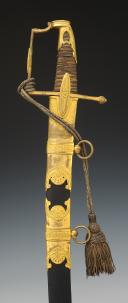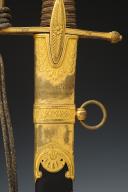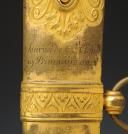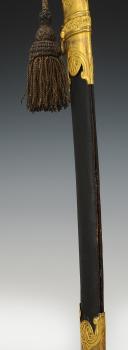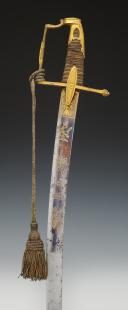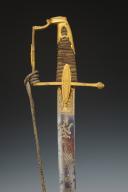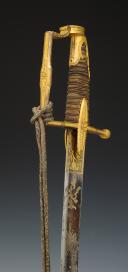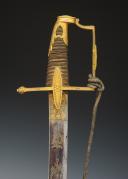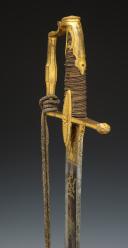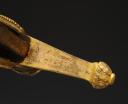
REWARD SABER of 19 BRUMAIRE YEAR 8, GIVEN BY THE FIRST CONSUL BONAPARTE, MANUFACTURE OF VERSAILLES, signed NICOLAS BOUTET, Consulate. 26353
REWARD SABER of 19 BRUMAIRE YEAR 8, GIVEN BY THE FIRST CONSUL BONAPARTE, MANUFACTURE OF VERSAILLES, signed NICOLAS BOUTET, Consulate. 26353
Golden brass frame. Guard with a straight branch chiseled with foliage and a fleuron, straight cross, elliptical earpieces similarly decorated on the guard branch, cross signed below "Boutet Director Artist / Manufre à Versailles", cap called "à l' German" at an almost right angle with a flat pommel, it is cut and openworked in scallops, rocket entirely filigree with golden threads. Curved blade with hollow sides, engraved and gilded on its first third with military trophies, floral decorations and civic crowns on a blued background, back of the blade signed "KLINGENTHAL". Length 80.3cm. Wooden scabbard covered with black waxed calfskin, with three gilt brass fittings, cut into very pronounced scallops, chiselled with acanthus leaves, cobwebs and palm leaves, cut iron dart, the yoke is engraved with before the inscription "Day of St-Cloud / 19 Brumaire year 8". Total length of the weapon 96.5 cm. France. Consulate. Good condition, blade with some oxidation, blued past, gilding rubbed on the smooth parts of the sheath fittings, in particular on the bouterolle which is split on the outer side.
ORIGIN Former Paul Jean collection, then Charles Marchal (1976).
KNOWN EXAMPLES
This type of saber was ordered from the Manufacture de Versailles by the most famous furbisher of the time, Nicolas Boutet.
There was no specific model, as was the case with honor weapons. The order was placed for a certain number of specimens, Nicolas Boutet drew from its stocks of models available for the weapons of national reward and weapons of luxury of the general officers. Among the known specimens, we have never encountered perfectly identical specimens.
Two main types are encountered more frequently.
1- Type with pommel in the spirit of German guards for light cavalry, flat on top and forming a right angle with a short tail. The mumps of the cruise can be thin and oval (the example presented here, the former Charles Marchal collection presented at the Biennale des antiquaires de Paris in 1976, from the collection of the antique dealer Paul Jean), or lozenge-shaped ( a copy from the former Charles Marchal collection presented at the Biennale des Antiquaires de Paris in 1978, attributed according to Charles Marchal to Augereau). Generally this type is accompanied by a wooden scabbard sheathed in black waxed calfskin with three fittings with scalloped edges. Several variants exist close to this type of saber with variants in the guards.
2- Type with pommel in the shape of an acanthus leaf rolling up on itself: the saber that belonged to Jean-Baptiste Bessière (collection of the Musée de l'Armée); a copy in the private collection (former Charles Marchal collection in the 1980s), Charles Marchal attributed it to General Villatte. On this type of saber, the scabbard is most often with two large fittings of gilded brass, connected to each other by two splints with a center revealing the wood of the scabbard covered with black waxed calfskin. There are also fairly similar variants with a pommel in the shape of a lion's head.
This saber is widely used later for general officers.
3- Other specimens were also used to reward this day, Charles Marchal exhibited in 1978 a saber with guard called Marengo with inverted double-quillon, in an oriental style, for example.
These luxury sabers are made up of interchangeable parts from one copy to another, allowing extreme customization, and so Nicolas Boutet proposed to personalize each saber to prevent all officers from having identical models.
ON 18 BRUMAIRE AN VIII, Bonaparte's accession to power.
This saber model is particularly representative of Bonaparte's accession to power, it is the turning point in the history of France between the Revolution and the First Empire.
The coup d'etat of 18 brumaire year VIII (9 November 1799), often abbreviated as the coup d'etat of 18 brumaire, organized by Emmanuel-Joseph Sieyès and carried out by Napoleon Bonaparte, with the decisive help of his brother Lucien, marked the end of the Directory and the French Revolution, and the beginning of the Consulate. If the decisive events occur on 19 Brumaire at the Château de Saint-Cloud where the Council of Five Hundred and the Council of Elders are meeting, it is on the 18 that the conspiracy puts in place the elements necessary for the plot.
Golden brass frame. Guard with a straight branch chiseled with foliage and a fleuron, straight cross, elliptical earpieces similarly decorated on the guard branch, cross signed below "Boutet Director Artist / Manufre à Versailles", cap called "à l' German" at an almost right angle with a flat pommel, it is cut and openworked in scallops, rocket entirely filigree with golden threads. Curved blade with hollow sides, engraved and gilded on its first third with military trophies, floral decorations and civic crowns on a blued background, back of the blade signed "KLINGENTHAL". Length 80.3cm. Wooden scabbard covered with black waxed calfskin, with three gilt brass fittings, cut into very pronounced scallops, chiselled with acanthus leaves, cobwebs and palm leaves, cut iron dart, the yoke is engraved with before the inscription "Day of St-Cloud / 19 Brumaire year 8". Total length of the weapon 96.5 cm. France. Consulate. Good condition, blade with some oxidation, blued past, gilding rubbed on the smooth parts of the sheath fittings, in particular on the bouterolle which is split on the outer side.
ORIGIN Former Paul Jean collection, then Charles Marchal (1976).
KNOWN EXAMPLES
This type of saber was ordered from the Manufacture de Versailles by the most famous furbisher of the time, Nicolas Boutet.
There was no specific model, as was the case with honor weapons. The order was placed for a certain number of specimens, Nicolas Boutet drew from its stocks of models available for the weapons of national reward and weapons of luxury of the general officers. Among the known specimens, we have never encountered perfectly identical specimens.
Two main types are encountered more frequently.
1- Type with pommel in the spirit of German guards for light cavalry, flat on top and forming a right angle with a short tail. The mumps of the cruise can be thin and oval (the example presented here, the former Charles Marchal collection presented at the Biennale des antiquaires de Paris in 1976, from the collection of the antique dealer Paul Jean), or lozenge-shaped ( a copy from the former Charles Marchal collection presented at the Biennale des Antiquaires de Paris in 1978, attributed according to Charles Marchal to Augereau). Generally this type is accompanied by a wooden scabbard sheathed in black waxed calfskin with three fittings with scalloped edges. Several variants exist close to this type of saber with variants in the guards.
2- Type with pommel in the shape of an acanthus leaf rolling up on itself: the saber that belonged to Jean-Baptiste Bessière (collection of the Musée de l'Armée); a copy in the private collection (former Charles Marchal collection in the 1980s), Charles Marchal attributed it to General Villatte. On this type of saber, the scabbard is most often with two large fittings of gilded brass, connected to each other by two splints with a center revealing the wood of the scabbard covered with black waxed calfskin. There are also fairly similar variants with a pommel in the shape of a lion's head.
This saber is widely used later for general officers.
3- Other specimens were also used to reward this day, Charles Marchal exhibited in 1978 a saber with guard called Marengo with inverted double-quillon, in an oriental style, for example.
These luxury sabers are made up of interchangeable parts from one copy to another, allowing extreme customization, and so Nicolas Boutet proposed to personalize each saber to prevent all officers from having identical models.
ON 18 BRUMAIRE AN VIII, Bonaparte's accession to power.
This saber model is particularly representative of Bonaparte's accession to power, it is the turning point in the history of France between the Revolution and the First Empire.
The coup d'etat of 18 brumaire year VIII (9 November 1799), often abbreviated as the coup d'etat of 18 brumaire, organized by Emmanuel-Joseph Sieyès and carried out by Napoleon Bonaparte, with the decisive help of his brother Lucien, marked the end of the Directory and the French Revolution, and the beginning of the Consulate. If the decisive events occur on 19 Brumaire at the Château de Saint-Cloud where the Council of Five Hundred and the Council of Elders are meeting, it is on the 18 that the conspiracy puts in place the elements necessary for the plot.
Price :
45 000,00 €
| Destination | Envoi recommandé | Envoi Recommandé + Express |
|---|---|---|
| Shipping France | 20,00 € | 80,00 € |
| Shipping Europe | 33,00 € | 200,00 € |
| Shipping world | 100,00 € | 300,00 € |
Insurance (1%) :
450,00 €
Reference :
26353 Proantic
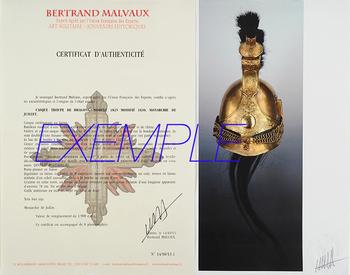
Next update Friday, april 18th at 13:30 PM
FOR ALL PURCHASES, PAYMENT IN MULTIPLE CHECKS POSSIBLE
bertrand.malvaux@wanadoo.fr 06 07 75 74 63
An authenticity certificate of the item including the description published on the site, the period, the sale price, accompanied by one or more color photographs is automatically provided for any item priced over 130 euros. Below this price, each certificate is charged 5 euros.
Only items sold by me are subject to an authenticity certificate, I do not provide any expert reports for items sold by third parties (colleagues or collectors).
